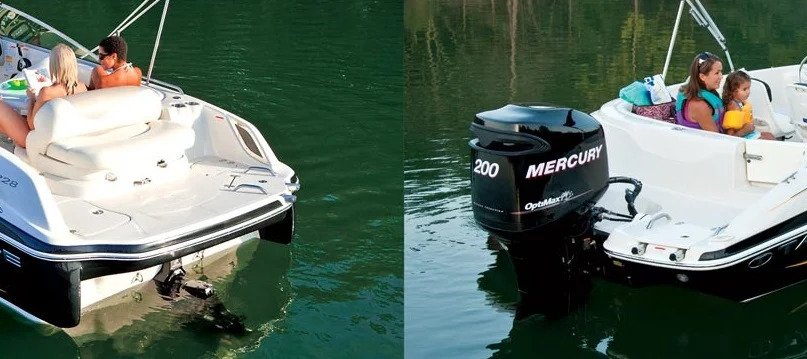Inboard VS Outboard Motors: Which is Best for Your Boat?

If you’re shopping for a new boat, whether you’re in the early stages of searching the internet, or you’re ready to pull the trigger, you might have questions when it comes to the engine. Depending on what type of boat you’re shopping for, you might have noticed that there are three main engine types to choose from. How will you decide? Do you know what’s best for your boat? How will this choice impact your day on the water?
I’m going to explain the three different engine types you will encounter to shed some light on what separates them. Let’s talk about outboards, inboards, and I/OSs (inboard/outboards). As we jump into comparing these engine types, it’s important to know a few facts behind the application of each. You will find that certain boat types only utilize one or the other.
First let me say that inboards and I/Os, are very similar. You could say they’re brothers as they are the same type of engine, the only difference is where the propeller is affixed to the boat. Now that I’ve made that distinction, let’s compare inboard engines to outboard engines. Inboards are traditionally found in fiberglass boats such as towboats and speed boats. Outboards are typically found on aluminum boats such as pontoons and fishing boats. That’s not set in stone, there are exceptions to both.
For instance, the region in which you boat can impact how the dealer orders their inventory and which engines they select. You might find a fiberglass speed boat with an inboard in the Midwest, but the same boat might have an outboard in the southeast due to the impacts of saltwater. As I mentioned, the engine is the same between inboards and I/Os. This is essentially a car engine and both sit down inside of the boat under an enclosure. Where the propeller sits in relation to the engine is the main difference in these two options. The propeller for an inboard is tucked underneath the boat whereas the prop for an I/O sticks off of the stern, fully submerged underwater. An I/O, or stern drive, is not common on boats that are used for watersports because of where the propeller sits. The advantage to an I/O over an inboard is the ability to trim the propeller. To trim an engine means to lift it in and out of the water using controls at the helm.
You are able to trim the propeller because it has clearance due to where it’s positioned on the boat. You are unable to trim the propeller on a true inboard because it’s affixed under the boat. There are two types of inboards, a v-drive and a direct drive. A direct drive engine is located in the center of the boat. This is typically found in ski boats and offers lots of torque and the perfect weight balance for skiing. A v-drive engine is located in the stern and is typically found in today’s wake surfing boats. With both a v-drive and direct drive, the prop is in the same spot underneath the hull.
Now let’s dig into the main differences between inboards and outboards. The placement of the engine depends on which type you choose. Where the engine is located is a major difference between an inboard and an outboard motor. Outboards are positioned up out of the water (hence the name) and take up space off of the stern. About 90% of the engine itself is always above water. The lower unit and propeller are the only parts that become submerged when the trim is in the downward position. That said, an outboard engine is always visible and will not allow you to enter or exit from the middle of the aft deck. This positioning can become a hindrance for things such as wake surfing or entering and exiting the water. That’s because the propeller is more invasive and can be dangerous if you are close to the engine while the boat is running.
As I mentioned above, an inboard motor is located inside of the boat and is covered by an enclosure or a bench-style seat or lounge. The positioning of an inboard allows the propeller to be tucked up underneath the boat making it less invasive and safer for entering and exiting the boat. They also produce a larger wake than outboards. Both favorable attributes for serious watersports enthusiasts. Where the inboard sits inside of the boat will take away from space onboard, whereas outboards take up no room inside the boat. This can have an impact if you’re looking to maximize the space for your crew or storage needs. Where these two types of engines are placed on the boat is the biggest factor in what separates them. There are a few more distinctions that might help you make a decision between one or the other.
View the full article here.
